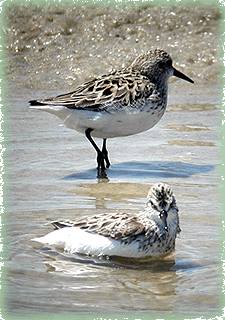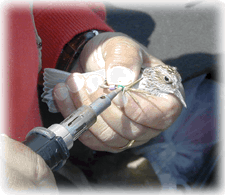 |
|
|||
Objectives At the end of the lesson, students will be able to:
Materials Video: The Crabs, the Birds, the Bay, To obtain a copy of the video, please call New Jersey Audubon Society, Center for Research and Education at (609) 861-0700. Copy Me pages 1 and 2 Making Connections The horseshoe crab harvest is a New Jersey environmental issue. This activity provides students with background information about the interaction between the shorebirds and horseshoe crabs. It provides a framework for discussing solutions to the problem of a declining horseshoe crab population. Background Read The Crabs, the Birds, the Bay Supplemental Reading. For older students this can be copied and handed out as homework reading. The Crabs, the Birds, the Bay — Supplemental Reading Horseshoe crabs are not really crabs at all. They are the living fossils of a line of nearly extinct arthropods most closely related to modern spiders and mites. Horseshoe crab fossils have been found as far back as 360 million years in the fossil record. Their anatomy hasn’t changed much over time. Horseshoe crabs have ten legs that they use to hold and crush prey. They feed on mollusks along the bottom of the bay. To breathe, the horseshoe crab relies on a book lung similar to that found in land spiders. The book lung is a series of membranes that extract oxygen from water. The membranes are arranged much like the pages of a book, hence the term book lung. Unlike terrestrial spiders, the horseshoe crab cannot breathe for long out of water. The book lungs must stay moist. Horseshoe crabs mate in mid-May. The full moon in May guarantees a high tide which carries the horseshoe crabs onto beaches for spawning. The warm waters and warm sunny days of May are just the right conditions for incubating the horseshoe crab young. A single female horseshoe crab can lay up to 7,000 eggs in a single deposit. Over the course of three weeks, she may lay 88,000 eggs.
Horseshoe crabs that survive the feeding frenzy on the beach face more predators as they are swept out to sea. Immature horseshoe crabs are a favorite food of juvenile loggerhead turtles and finfish. It takes 10 years for a horseshoe crab to reach maturity. During that decade, an individual must survive natural predation and human predation. Horseshoe crabs have been harvested for at least the past century. They were used in the 1880’s for bait and fertilizer. The availability of cheaper artificial fertilizers (that didn’t smell like dead horseshoe crabs) lead to a decline in horseshoe crab harvesting around the 1940’s. As horseshoe crab populations increased, shorebird populations increased. The peak of shorebird migration during the late 1980’s coincided with a peak in the Atlantic horseshoe crab population. Delaware Bay is complex ecosystem that is heavily used by humans for shipping, fishing, and boating. Off-loading of oil tankers is a constant threat to the bay ecosystem. Loss of habitat to developments along the Delaware Bay has potential impact on organisms that depend on the food web of the Bay. Although horseshoe crabs have no food value for humans, they are harvested as bait for eel and conch. Habitat loss along the Japanese coastline has placed the Asian horseshoe crab on the endangered species list. Commercial fishermen along Delaware Bay have found a lucrative business selling horseshoe crabs to eel and conch harvesters. Most of the eel and conch finds its way to Japanese markets. There is some concern that if prudent management is not followed the Atlantic horseshoe crab will join the endangered species list along with the migratory species who rely on its annual cycle of spawning in the Delaware Bay. Procedure Warm Up Explain to students that they will be watching a video about the horseshoe crabs and migratory birds of Delaware Bay. Quickly sample for prior knowledge regarding the location of the Delaware Bay, horseshoe crabs, and shorebirds. Tell students that they will be answering questions about the location, region, place, movement, and human-environment interactions taking place in the Delaware Bay. The Activity
Assessment Check student responses to geographic questions. Evaluate writing activity for understanding of how human activity regarding horseshoe crab harvesting can be both the cause and solution to the problem of declining migratory shorebird populations. Extensions Do the Shorebird Migration Activity. Please download the PDF for the complete Lesson Plan. New Jersey Audubon Society - Cape May Bird Observatory Center for Research Wetlands Institute Endangered and Nongame Species Program |
|||

 Subject Areas
Subject Areas  Not all horseshoe crab eggs hatch or reach maturity. One of the truly incredible migratory spectacles occurs each May along Delaware Bay. Thousands of shorebirds stop on their migration from South and Central America to feast on the horseshoe crab eggs. It takes about four horseshoe crabs to support the dietary needs of one hungry shorebird. Semipalmated sandpipers, ruddy turnstones, red knots, and sanderlings scurry across the wet sandy beaches in search of horseshoe crab eggs. However, migratory shorebirds are not the only consumers. Laughing gulls, ring-billed gulls, dowitchers, and dunlins compete for the rich nutrition that the horseshoe crab eggs provide. The search for the tiny eggs in the sand is a frenzied blur of flying feet, feathers, and beaks. The ruddy turnstone actually turns over the sand with its beak to find the eggs. The sandpipers move methodically along in a sewing-machine-needle motion, meticulously picking up the eggs from near the surface of the sand. Laughing gulls who nest in nearby marshes contribute the most noise as they comb the shoreline for eggs. As their name implies, they make a loud, shrieking, high-pitched laughing sound.
Not all horseshoe crab eggs hatch or reach maturity. One of the truly incredible migratory spectacles occurs each May along Delaware Bay. Thousands of shorebirds stop on their migration from South and Central America to feast on the horseshoe crab eggs. It takes about four horseshoe crabs to support the dietary needs of one hungry shorebird. Semipalmated sandpipers, ruddy turnstones, red knots, and sanderlings scurry across the wet sandy beaches in search of horseshoe crab eggs. However, migratory shorebirds are not the only consumers. Laughing gulls, ring-billed gulls, dowitchers, and dunlins compete for the rich nutrition that the horseshoe crab eggs provide. The search for the tiny eggs in the sand is a frenzied blur of flying feet, feathers, and beaks. The ruddy turnstone actually turns over the sand with its beak to find the eggs. The sandpipers move methodically along in a sewing-machine-needle motion, meticulously picking up the eggs from near the surface of the sand. Laughing gulls who nest in nearby marshes contribute the most noise as they comb the shoreline for eggs. As their name implies, they make a loud, shrieking, high-pitched laughing sound. Wrap Up
Wrap Up